Abstract
Several human neurological disorders are associated with proteins containing abnormally long runs of glutamine residues. Strikingly, most of these proteins contain two or more additional long runs of amino acids other than glutamine. We screened the current human, mouse, Drosophila, yeast, and Escherichia coli protein sequence data bases and identified all proteins containing multiple long homopeptides. This search found multiple long homopeptides in about 12% of Drosophila proteins but in only about 1.7% of human, mouse, and yeast proteins and none among E. coli proteins. Most of these sequences show other unusual sequence features, including multiple charge clusters and excessive counts of homopeptides of length > or = two amino acid residues. Intriguingly, a large majority of the identified Drosophila proteins are essential developmental proteins and, in particular, most play a role in central nervous system development. Almost half of the human and mouse proteins identified are homeotic homologs. The role of long homopeptides in fine-tuning protein conformation for multiple functional activities is discussed. The relative contributions of strand slippage and of dynamic mutation are also addressed. Several new experiments are proposed.
Full text
PDF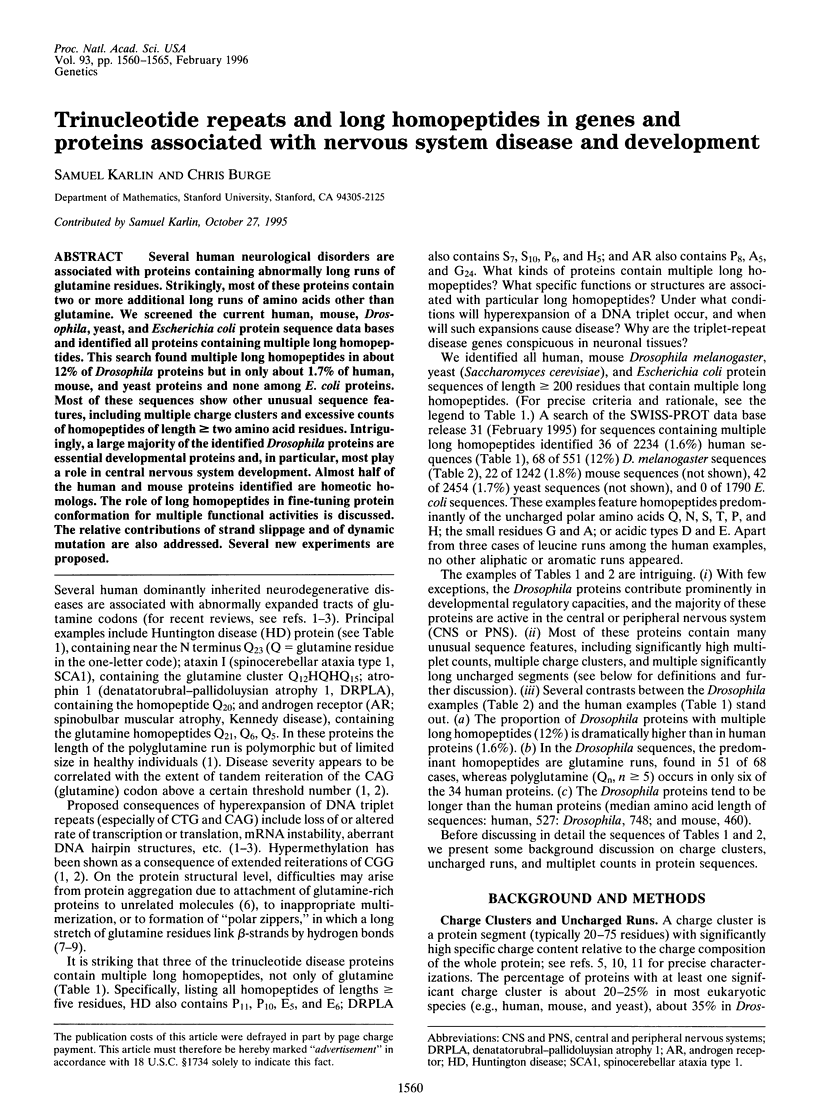
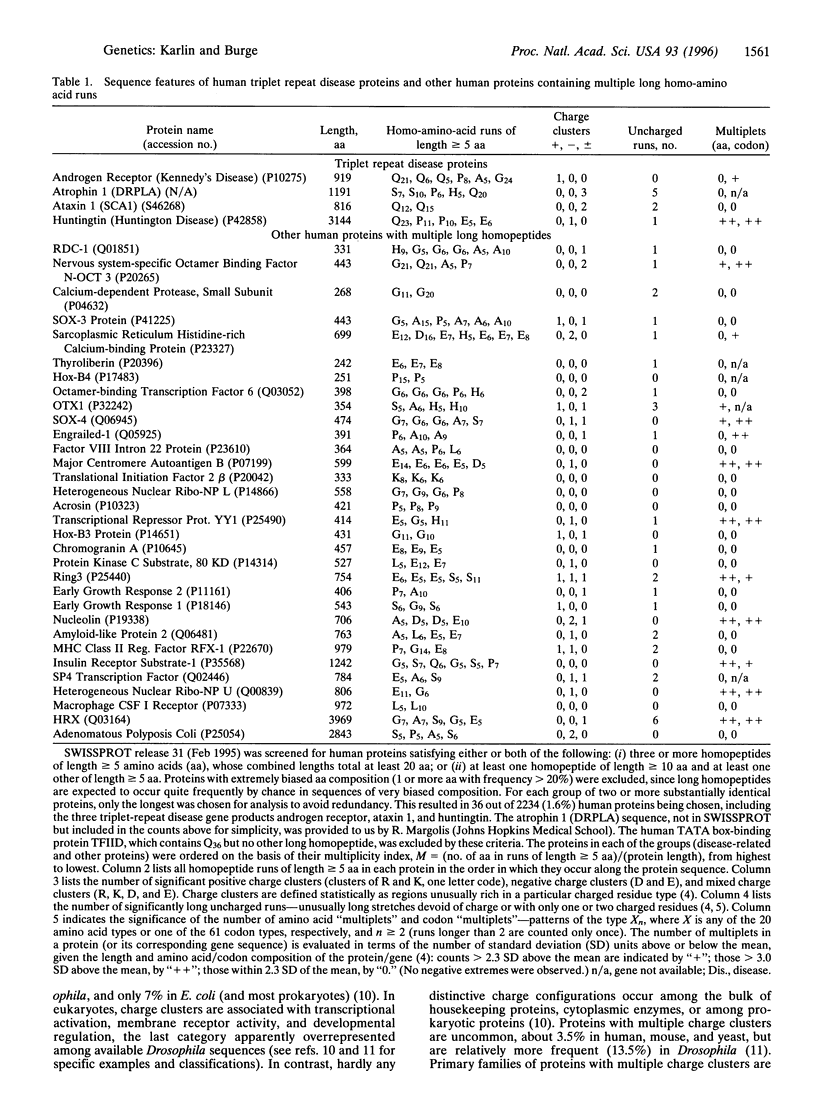
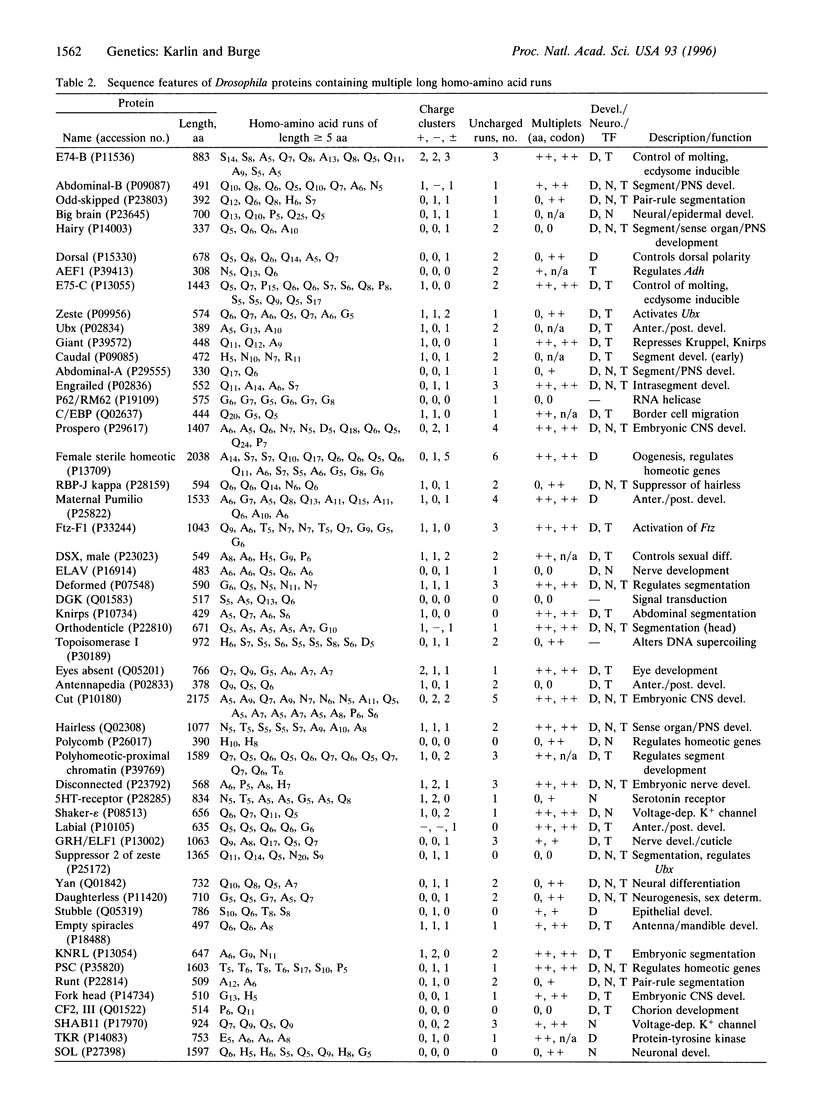

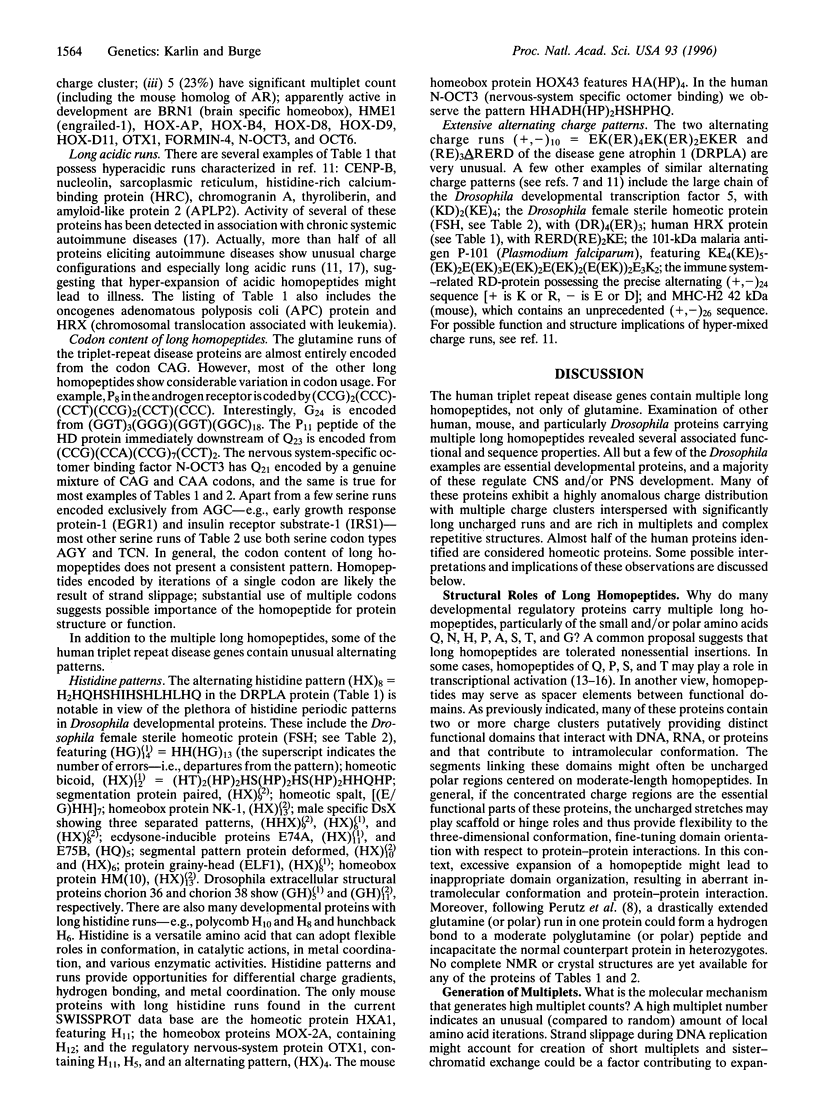
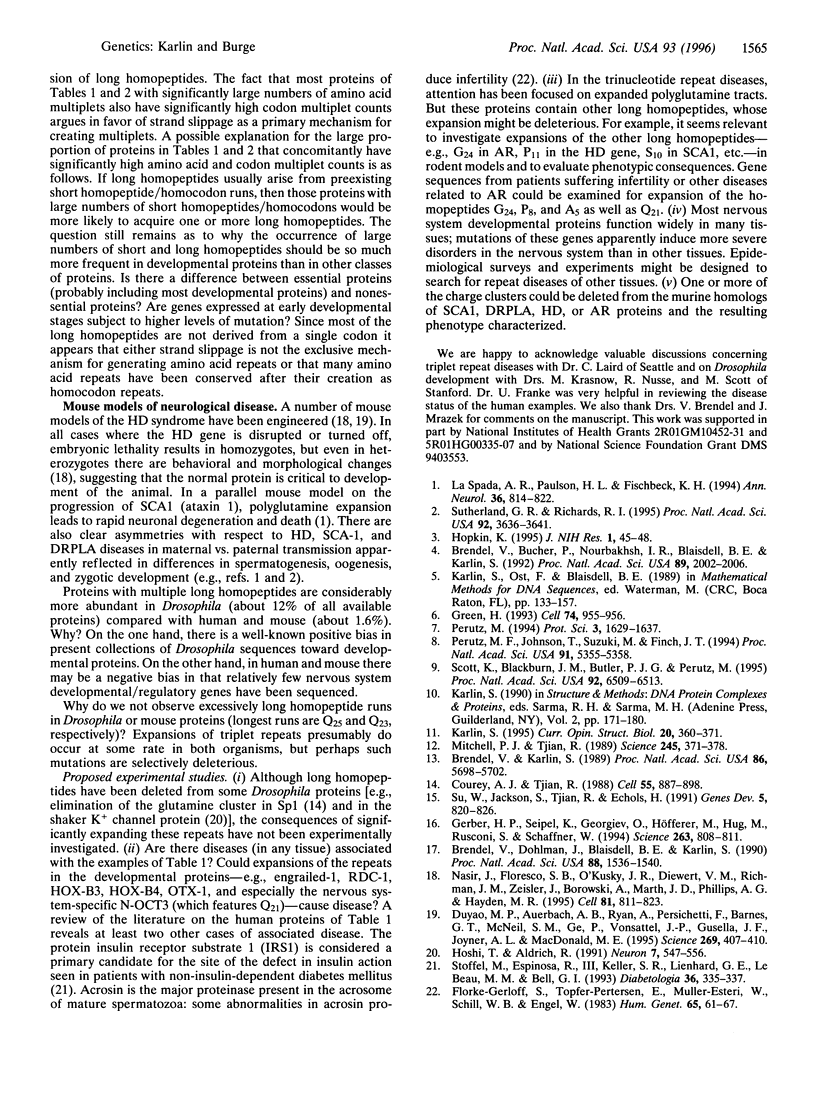
Selected References
These references are in PubMed. This may not be the complete list of references from this article.
- Brendel V., Bucher P., Nourbakhsh I. R., Blaisdell B. E., Karlin S. Methods and algorithms for statistical analysis of protein sequences. Proc Natl Acad Sci U S A. 1992 Mar 15;89(6):2002–2006. doi: 10.1073/pnas.89.6.2002. [DOI] [PMC free article] [PubMed] [Google Scholar]
- Brendel V., Dohlman J., Blaisdell B. E., Karlin S. Very long charge runs in systemic lupus erythematosus-associated autoantigens. Proc Natl Acad Sci U S A. 1991 Feb 15;88(4):1536–1540. doi: 10.1073/pnas.88.4.1536. [DOI] [PMC free article] [PubMed] [Google Scholar]
- Brendel V., Karlin S. Association of charge clusters with functional domains of cellular transcription factors. Proc Natl Acad Sci U S A. 1989 Aug;86(15):5698–5702. doi: 10.1073/pnas.86.15.5698. [DOI] [PMC free article] [PubMed] [Google Scholar]
- Courey A. J., Tjian R. Analysis of Sp1 in vivo reveals multiple transcriptional domains, including a novel glutamine-rich activation motif. Cell. 1988 Dec 2;55(5):887–898. doi: 10.1016/0092-8674(88)90144-4. [DOI] [PubMed] [Google Scholar]
- Duyao M. P., Auerbach A. B., Ryan A., Persichetti F., Barnes G. T., McNeil S. M., Ge P., Vonsattel J. P., Gusella J. F., Joyner A. L. Inactivation of the mouse Huntington's disease gene homolog Hdh. Science. 1995 Jul 21;269(5222):407–410. doi: 10.1126/science.7618107. [DOI] [PubMed] [Google Scholar]
- Flörke-Gerloff S., Töpfer-Petersen E., Müller-Esterl W., Schill W. B., Engel W. Acrosin and the acrosome in human spermatogenesis. Hum Genet. 1983;65(1):61–67. doi: 10.1007/BF00285030. [DOI] [PubMed] [Google Scholar]
- Gerber H. P., Seipel K., Georgiev O., Höfferer M., Hug M., Rusconi S., Schaffner W. Transcriptional activation modulated by homopolymeric glutamine and proline stretches. Science. 1994 Feb 11;263(5148):808–811. doi: 10.1126/science.8303297. [DOI] [PubMed] [Google Scholar]
- Green H. Human genetic diseases due to codon reiteration: relationship to an evolutionary mechanism. Cell. 1993 Sep 24;74(6):955–956. doi: 10.1016/0092-8674(93)90718-6. [DOI] [PubMed] [Google Scholar]
- Hoshi T., Zagotta W. N., Aldrich R. W. Two types of inactivation in Shaker K+ channels: effects of alterations in the carboxy-terminal region. Neuron. 1991 Oct;7(4):547–556. doi: 10.1016/0896-6273(91)90367-9. [DOI] [PubMed] [Google Scholar]
- Karlin S. Statistical significance of sequence patterns in proteins. Curr Opin Struct Biol. 1995 Jun;5(3):360–371. doi: 10.1016/0959-440x(95)80098-0. [DOI] [PubMed] [Google Scholar]
- La Spada A. R., Paulson H. L., Fischbeck K. H. Trinucleotide repeat expansion in neurological disease. Ann Neurol. 1994 Dec;36(6):814–822. doi: 10.1002/ana.410360604. [DOI] [PubMed] [Google Scholar]
- Mitchell P. J., Tjian R. Transcriptional regulation in mammalian cells by sequence-specific DNA binding proteins. Science. 1989 Jul 28;245(4916):371–378. doi: 10.1126/science.2667136. [DOI] [PubMed] [Google Scholar]
- Nasir J., Floresco S. B., O'Kusky J. R., Diewert V. M., Richman J. M., Zeisler J., Borowski A., Marth J. D., Phillips A. G., Hayden M. R. Targeted disruption of the Huntington's disease gene results in embryonic lethality and behavioral and morphological changes in heterozygotes. Cell. 1995 Jun 2;81(5):811–823. doi: 10.1016/0092-8674(95)90542-1. [DOI] [PubMed] [Google Scholar]
- Perutz M. F., Johnson T., Suzuki M., Finch J. T. Glutamine repeats as polar zippers: their possible role in inherited neurodegenerative diseases. Proc Natl Acad Sci U S A. 1994 Jun 7;91(12):5355–5358. doi: 10.1073/pnas.91.12.5355. [DOI] [PMC free article] [PubMed] [Google Scholar]
- Perutz M. Polar zippers: their role in human disease. Protein Sci. 1994 Oct;3(10):1629–1637. doi: 10.1002/pro.5560031002. [DOI] [PMC free article] [PubMed] [Google Scholar]
- Stoffel M., Espinosa R., 3rd, Keller S. R., Lienhard G. E., Le Beau M. M., Bell G. I. Human insulin receptor substrate-1 gene (IRS1): chromosomal localization to 2q35-q36.1 and identification of a simple tandem repeat DNA polymorphism. Diabetologia. 1993 Apr;36(4):335–337. doi: 10.1007/BF00400237. [DOI] [PubMed] [Google Scholar]
- Stott K., Blackburn J. M., Butler P. J., Perutz M. Incorporation of glutamine repeats makes protein oligomerize: implications for neurodegenerative diseases. Proc Natl Acad Sci U S A. 1995 Jul 3;92(14):6509–6513. doi: 10.1073/pnas.92.14.6509. [DOI] [PMC free article] [PubMed] [Google Scholar]
- Su W., Jackson S., Tjian R., Echols H. DNA looping between sites for transcriptional activation: self-association of DNA-bound Sp1. Genes Dev. 1991 May;5(5):820–826. doi: 10.1101/gad.5.5.820. [DOI] [PubMed] [Google Scholar]
- Sutherland G. R., Richards R. I. Simple tandem DNA repeats and human genetic disease. Proc Natl Acad Sci U S A. 1995 Apr 25;92(9):3636–3641. doi: 10.1073/pnas.92.9.3636. [DOI] [PMC free article] [PubMed] [Google Scholar]


